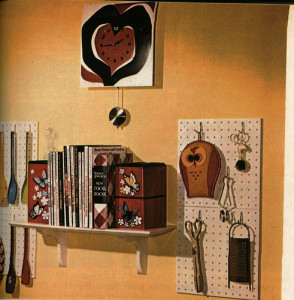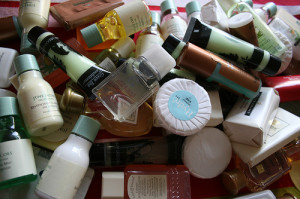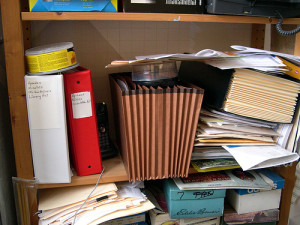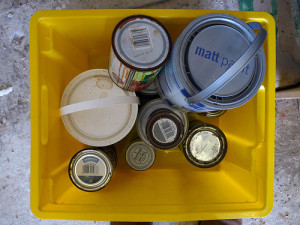We know it’s not spring yet, and you’re still donning that oversize wool coat and chunky scarf. But we admit that we are still in a post-holiday funk and are in serious need of some organization and motivation.
So we took a room-by-room tour around our own homes to find the solutions the your biggest clutter conundrums, disposal dilemmas and decorating difficulties.
Living Room
Problem: I have a truckload of defunct electronics.
No it’s not a good idea to set that bulky 1980s television on the curb in hopes that your trash collector will pick it up. E-waste is a serious issue for landfills because of the hazardous materials found in electronics (would you like some lead, mercury or cadmium in your drinking water?).

Look cozy? All you may need to spice up your living room is a simple change in the way it is lit. Photo: Flickr/TomBorowski
According to a new survey by Pike Research, the average consumer has 2.8 unused electronic devices sitting around the house.
Try searching for an e-waste event or recycling program in your local area on Earth911. Here are some other solutions we like:
DVDs and CDs – Two excellent resources for disc disposal are Back Thru the Future and the CD Recycling Center of America. While you pay the shipping costs, there is no recycling fee at either of these organizations. Remember to use the U.S. Postal Service’s “media rate” for the best prices.
Televisions – After television stations switched to digital signals in February 2009, the number of televisions disposed of increased. For information on television take-back programs and to see how well manufacturers scored on their recycling efforts, visit TakeBackMyTv.com.
Problem: My furniture is less than lack-luster.
This author had a bright red couch, which, at the time, seemed like smart and stylish purchase for her living room. But after countless movie nights, Sunday afternoon naps and TV marathons, that cherry red turned into a dull pink eyesore. But instead of buying a new couch (which could run you more than $1,000), consider using a slipcover. We really like Sure Fit, which has slipcovers of all brands for chairs, loveseats and sofas. If you’re really ambitious, you can even make your own cover.
Problem: It’s just not cozy.
It may not seem like a big deal, but the ambiance of your home is all about the way it’s lit. That off-balance ceiling fan may be directly affecting the “glow” of the room. But before you rip it out and spend hundreds to replace it, consider that it may just be the bulbs. Do you really need four 70-watt bulbs for 200 square feet? Probably not.
Make the switch to a more energy-efficient bulb. Yes, there will be an upfront cost. CFLs can cost up to 10 times more than an incandescent bulb, and the even more energy-efficient LEDs can cost up to $50 for a single bulb. However, the cost difference is typically negated both in energy bill savings and longevity of the bulb. Typical incandescent bulbs last only 1,000 to 2,000 hours, while some estimates quote LED lifespans from 25,000 to 50,000 hours.
Kitchen
Problem: My appliances are outdated.
Then you are one lucky consumer right now. Last the month, the government rolled out its Cash for Appliances program, which will utilize nearly $300 million from the American Recovery and Reinvestment Act to fund a rebate program that encourages consumers to purchase ENERGY STAR certified appliances. But get out your checkbook. Be prepared to budget about $550 to $8,500 for a refrigerator and $250 to $1,650 for dishwasher. It may seem like more money, but you’ll save $240 to $340 annually.

Running out of cabinet space? Don't forget about your walls for your cookbooks, utensils and other odds and ends. Photo: Flickr/turkeychik
Problem: I have no space.
We’ve seen great cooks in kitchens that are too small to open the refrigerator and stove door at the same time (true story for this author’s college digs). A tall order it may seem, but creating more kitchen space is easier (and cheaper) than you think, and it doesn’t include a sledgehammer and a week-long kitchen remodel.
- Start by cleaning out your kitchen cupboards. Recycle and donate what you can. This will give you more storage space for items that you may not use every day and do not need on your counter top (such as your blender).
- Think about your space from floor to ceiling – including your walls. You can easily hang pots and pans, oven mitts or your spice rack. Check out Space Savers for creative organization solutions.
- Don’t forget about the cabinet doors. Look for over-the-door organizers to hold lightweight items like Tupperware lids or dish towels.
- Put your dishes on double duty. Use your “I Heart NY” mug as utensil storage, that mason jar for macaroni noodles and your serving bowl for a fresh fruit display.
Problem: I want to recycle, but I don’t know where to start.
Although there are general guidelines for recycling, unfortunately there is no one unified nationwide recycling program. Because of this, you should start out your at-home recycling quest by researching your community’s recycling policies and procedures.
If your local recycling is single-stream, you can put all your recyclables into one bin. If it is dual-stream, your recyclables will need to be separated. You can do this by breaking your waste up into categories such as paper and cardboard, plastics, glass, certain metals and other material types.
Put a personal spin on your bin to really get everyone involved. Once your container system is ready, decorate it and designate its location. Here’s a quick tip: Three things that are recyclable that you will usually find in kitchen are plastic bottles, paper packaging and aluminum cans.
Bathroom
Problem: I use way too much water.
The average faucet flows at a rate of 2 gallons per minute, and a five-minute shower uses 10 to 25 gallons of water. So, we’re going back to elementary school for this one. Turning off the water when you brush and shave, taking shorter showers and flushing judiciously can all save hundreds of gallons of water.

Look familiar? Most of those shampoo and soap bottles are made of recyclable plastic. They also make for great travel-size containers. Photo: Flickr/tiddlywinker
Take it a step further and install a low-flow showerhead or an aerator on your sink. Together they can reduce your household water use by up to 50 percent, which will save you money.
Problem: It’s a mess under my sink.
You know what we’re referring to: half-empty shampoo bottles, lotions with intolerable fragrances and once-trendy-now-gaudy cosmetics. Consolidate what’s possible, and remember to recycle the containers.
Rethinking the way you use hygiene products starts here. Read the backs of your bottles. Some personal hygiene and beauty products contain harmful substances known to be skin irritants, poisons and even carcinogens.
So, which ingredients should you avoid and what products might contain them? In partnership with the Environmental Working Group, the Campaign for Safe Cosmetics has created Skin Deep, an online database of cosmetics and personal care products where you can check your sunscreen, shampoo, deodorant, shaving cream and more for toxic ingredients.
Problem: It needs a super clean, but the fumes are too much for the small space.
The next time you have to wipe down the bathroom counter and clean the mirror above the sink, opt for products with fewer chemicals. We’re all for sparkling counter tops, but most standard cleaning products can irritate allergies, cause headaches and make your eyes burn. In fact, the EPA is reevaluating the health impact of chemicals that are present in everyday products and has developed an action plan for the treatment of four chemicals including phthalates.
Look for nontoxic cleaners such as Seventh Generation. Or save some cash and make a super-duty cleaner with ingredients from your pantry:
Vinegar – Mix one part vinegar and one part water in a spray bottle to clean counter tops, sinks and floors.
Lemon – Scrub surfaces and stains with a lemon that has been cut in half and sprinkled with baking soda on the flat side.
Office
Problem: I literally have mountains of paper.
One of the biggest space hoarders in any office is files. Hundreds upon hundreds of contracts, reports and applications in file cabinets can take up an entire wall of space in your office.
Reassess what you really need in hard-copy form. Many of these documents can be scanned and saved in electronic form. Shred, bag and recycle the sheets of paper. The most important thing to remember here is to back up any information you load onto an external hard drive with password protection. You can go digital and still be safe.

It may seem like a ton of work, but it's worth it. Recycling 1 ton of paper saves 17 trees, two barrels of oil, 4,100 kilowatts of energy, 3.2 cubic yards of landfill space and 60 pounds of air pollution. Photo: Flickr/pigdump
Problem: Nothing is “green” or efficient.
According to the Department of Energy, office equipment accounts for 16 percent of an office’s energy use. The use of computers, printers, copiers and fax machines adds up, but simply turning your computer’s sleep mode on when you’re not using it can save energy. Here are some other energy-saving tips you can implement:
- Turn the machine off when you leave the office for the night.
- Activate sleep mode for printers, copiers and fax machines so they’ll sense inactive periods.
- Consider consolidating these machines by purchasing a machine that performs multiple office functions.
If you’re looking to purchase new office equipment, look for ENERGY STAR qualified products to cut down energy use and pollution.
Problem: I just can’t concentrate in my workspace.
Organization plays a key role in productivity. A clean space allows for more creativity and better concentration. But if you’re still in a jaded funk after organizing your office, a fresh coat of paint may do the trick and get you back on track.
According to Freshome Interior Design, color and mood go hand-in-hand. Blues and greens are great for reducing stress and relaxing. But if you’re looking for a burst of creativity and energy, paint one wall a shade of red or orange.
Earth911 consulted Behr paint to find out more about the color trends for 2010. “Whether light or dark, clean or muted, traditional or contemporary, new concepts in style take shape at the beginning of a new decade,” according to Behr’s 2010 Design & Color Trends report, noting that contrasting shades are tops this year, and that these palettes relate directly to “a world bursting with change, innovation and diversity.”
Garage
Problem: I have boxes of stuff I never use.
The garage is where products go to collect dust. You don’t plan on using them, but you store them in a corner “just in case.” Sporting goods, books, old electronics – all these items can be reused by someone else, reducing the need to manufacture new products.

Due to the various types of cleaning products, there are several methods for properly disposing of them. Household cleaning products that are hazardous should be properly disposed of by household hazardous waste (HHW) facilities. Photo: Flickr/eatmorechips
They don’t call it a garage sale for nothing. If you moved all your junk from the garage out to the driveway, you may be surprised what gets sold. Use sites like Craigslist and Freecycle or scout out a second-hand store to get a tax write-off.
Problem: It’s too cold.
Yes, this is an energy-sucking problem. The garage is probably one of your least insulated rooms in the house. It will be coldest in the winter, and warmest in the summer.
Minimize this impact by keeping any doors closed that connect the garage with your house. This will keep your energy costs down for heating and cooling your home.
Also keep in mind that extra appliances, like spare refrigerators and freezers, can take a toll on your electric bill. A refrigerator uses almost five times more electricity than the average television.
Rather than combating constant temperature fluctuations, assess if you really need a second refrigerator. If so, perhaps a smaller unit for beverages will work better than a full-size cooler.
Problem: I don’t know what to do with all these chemicals.
The garage is a popular spot for hazardous products like motor oil, freon, gasoline, pool chemicals, etc. If you’re housing these items, make sure they are properly stored in their containers. If you need to get rid of any old supplies, don’t dump them in the trash. Check for a local household hazardous waste collection event hosted by your municipality, or look for other ways to properly dispose of these items with Earth911’s recycling database.


Comments(0)